Coordinators:
?
Vega rings
Vega PDFs
Vega 1cy August
Vega 1cy September
Vega 1cy October
Vega 1cy November
Vega 1cy December
Vega 2cy January
Vega 2cy February
Vega 2cy March
Vega 2cy April
Vega 2cy May
Vega 2cy June
Vega 2cy July
Vega 2cy August
Vega 2cy September
Vega 2cy October
Vega 2cy November
Vega 2cy December
Vega 3cy January
Vega 3cy February
Vega 3cy March
Vega 3cy April
Vega 3cy May
Vega 3cy June
Vega 3cy July
Vega 3cy August
Vega 3cy September
Vega 3cy October
Vega 3cy November
Vega 3cy December
Vega sub-ad January
Vega sub-ad February
Vega sub-ad March
Vega sub-ad April
Vega sub-ad May
Vega sub-ad June
Vega sub-ad July
Vega sub-ad August
Vega sub-ad September
Vega sub-ad October
Vega sub-ad November
Vega sub-ad December
Vega ad January
Vega ad February
Vega ad March
Vega ad April
Vega ad May
Vega ad June
Vega ad July
Vega ad August
Vega ad September
Vega ad October
Vega ad November
Vega ad December
|
Vega Gull (vegae) 1st cycle / 1CY October
Juvenile feathers start to wear at the fringes. Some birds start to replace upper scapulars in the post-juvenile moult. These new, 2nd generation feathers differ from adjacent juvenile feathers by the buffish or greyish tone and darker central pattern.
Do we finally go Vega - part III?
>>> 1st cycle / 1st winter birds
>>>2nd cycle & immature birds
adult birds
Kirk Zufelt adult Vega Gull discussion. Terry Townsend on adult Vega:
However, there are features of vegae that are, on average, subtly different to argentatus. For example, in my experience (on adult birds):
– structure of vegae is, on average, heavier than argentatus
– white tertial band tends to be larger on vegae
– eye-ring tends to be more reddish on vegae than orange-yellow on argentatus
– legs tend to be brighter (more ‘raspberry’) pink on vegae than on argentatus
– black on wing-tips tends to be stronger, often reaching p4 (unusual on argentatus – 2 per cent according to Olsen and Larsson); white spots on primaries at rest tend to be smaller than argentatus
I should add that I thought the mantle colour of vegae looked very similar to argentatus (perhaps slightly darker than the British argenteus).
ADULT PLUMAGES.
Adult Vega Gull vegae from NE Russia is a dark bird, matching darkest Scandinavian argentatus or Mediterraneanmichahellis. Luckily, darkest argentatus from N Norway are also birds with least black in the wingtip, while on the oppositevegae has much black in the wingtip. Below is a set of 9 characteristics for adult vegae.
Adult Vega Gull vegae
- grey tone is about Kodak 6-7(8), matching darkest Scandinavian argentatus or Mediterranean michahellis.
- much speckling in iris, creating dark-eyed effect at a distance.
- normally with broad black sub-terminal band on P5.
- Coral red orbital ring, pink legs (93% of the population).
- large white tips on secondaries.
Additional characteristics
- densely streaked winter head, running down in hindneck and breast.
- powerful bird, but well-proportioned, not bulky.
- mirror on P10 seprated from white tip by full black sub-terminal band.
- white tongue tips.
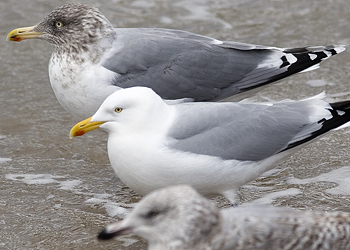 |
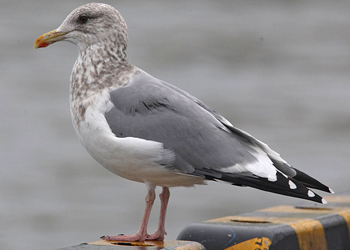 |
Herring Gull (argentatus) adult, February 07 2013, Katwijk, the Netherlands (Mars Muusse). Dark argentatus from Scandinavia, and adult argenteus (argentatus and vegae about equal in grey tone). P10: Mirror merges with tip, P9 with large mirror, no black spot on P5. |
Vega Gull (vegae) adult, December 2009 - January 2010, Choshi, Japan (Chris Gibbins). Dark iris, heavily streaked head continuing on upper breast, dark grey upperparts. Vegae has much black in wingtip. |
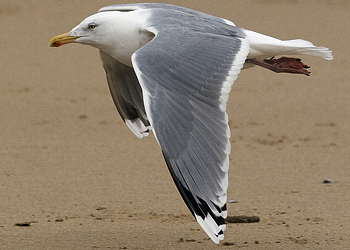 |
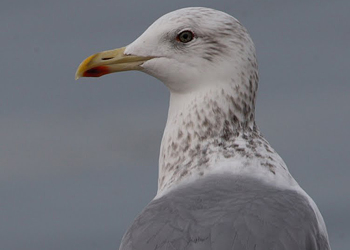 |
Herring Gull (argentatus) adult, February 14 2012, Noordwijk, the Netherlands (Mars Muusse). Thayeri pattern on P9 and P10, broken band on P7 and only faint black spots on P6. Probably from N Scandinavia. About Kodak 6-7 grey tone. |
Vega Gull (vegae) adult, December 2009 - January 2010, Choshi, Japan (Chris Gibbins). Dark iris, dark grey upperparts (Kodak 7-8). |
 |
 |
Herring Gull (argentatus) adult, December 02 2012, Katwijk, the Netherlands (Mars Muusse). In argentatus, northern birds are darker on upperparts, but also show less black in wingtip. Here, no sub-terminal band on P10, mirror on P9 covering both webs, no black spot on P5. Yellow orbital ring. |
Vega Gull (vegae) adult, December 2009 - January 2010, Choshi, Japan (Chris Gibbins). Dark iris, dark grey upperparts (Kodak 7-8), late moult (P8 fully grown, P9-P10 growing), and pink legs. Note purplish orbital ring. |
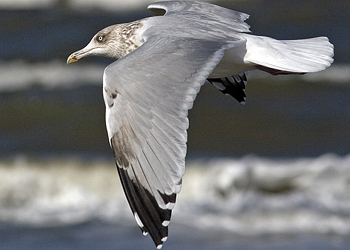 |
 |
Herring Gull 4cy, October 07 2012, Noordwijk, the Netherlands (Mars Muusse). Heavy streaking on head and breastcommon in full adult Vega Gull, in Europe more associated with immature birds. |
Vega Gull vegae adult, December 05 2012, Choshi, Japan (Hiyashi Haka). Late moult, P7/P10. Note deep coral red orbital ring and gape. Very heavy winter streaking, down on breast. Note large white neck patch above mantle. |
 |
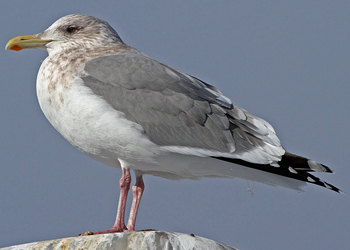 |
Herring Gull (argentatus) adult, December 02 2012, Katwijk, the Netherlands (Mars Muusse). Bird with more black on P9-P10, still no black on P5. Full sub-terminal band on P10, no mirror on P9. Yellow orbital ring. |
Vega Gull (vegae) adult, January 21 2011, Japan (Stuart Price). Dark iris, heavily streaked head continuing on upper breast, dark grey upperparts (Kodak 7-8), much black in wingtip (short tongue on P10 and full subterminal band on P10), broad secondary tips and pink legs. |
 |
 |
| Herring Gull adult, July 18 2013, Noordwijk, the Netherlands Mars Muusse. With immature Lesser Black-backed Gull in background. No black on P5. Black on outerweb of P8 not reaching to primary coverts. No obvious white tongue tips. Kodak 5-6 in continental argenteus. |
Vega Gull vegae adult, July 02 2013, Kamchatka, Russia (Benjamin van Doren. Full sub-terminal band on P5 and P10, with much black on outerweb of P5. Black on outerweb of P4. Black on outerweb of P8, P9 and P10 reach to primary coverts. Red orbital ring, yellow iris. Broad white trailing edge to secondaries. Large 'moons', white tongue tips on P5-P7 with sharp division between grey and white. |
.
ADULT PLUMAGES. |
|
 Vega Gull (vegae), 1st cycle (1CY), October 28 2005, Chashi, Japan. Picture: Akimichi Ariga. Vega Gull (vegae), 1st cycle (1CY), October 28 2005, Chashi, Japan. Picture: Akimichi Ariga. |
 Vega Gull (vegae)
Vega Gull (vegae)  / セグロカモメ
/ セグロカモメ  / 재갈매기
/ 재갈매기 
 Vega Gull (vegae), 1st cycle (1CY), October 28 2005, Chashi, Japan. Picture: Akimichi Ariga.
Vega Gull (vegae), 1st cycle (1CY), October 28 2005, Chashi, Japan. Picture: Akimichi Ariga. Vega Gull (vegae), 1st cycle (1CY), October 22 2005, Hasaki Xingang, Japan. Picture: Akimichi Ariga.
Vega Gull (vegae), 1st cycle (1CY), October 22 2005, Hasaki Xingang, Japan. Picture: Akimichi Ariga. Vega Gull (vegae), 1st cycle (1CY), October 07 2006, Kamisu, Japan. Picture: Seichoudoku.
Vega Gull (vegae), 1st cycle (1CY), October 07 2006, Kamisu, Japan. Picture: Seichoudoku. Vega Gull (vegae), 1st cycle (1CY), October 07 2006, Kamisu, Japan. Picture: Seichoudoku.
Vega Gull (vegae), 1st cycle (1CY), October 07 2006, Kamisu, Japan. Picture: Seichoudoku.










